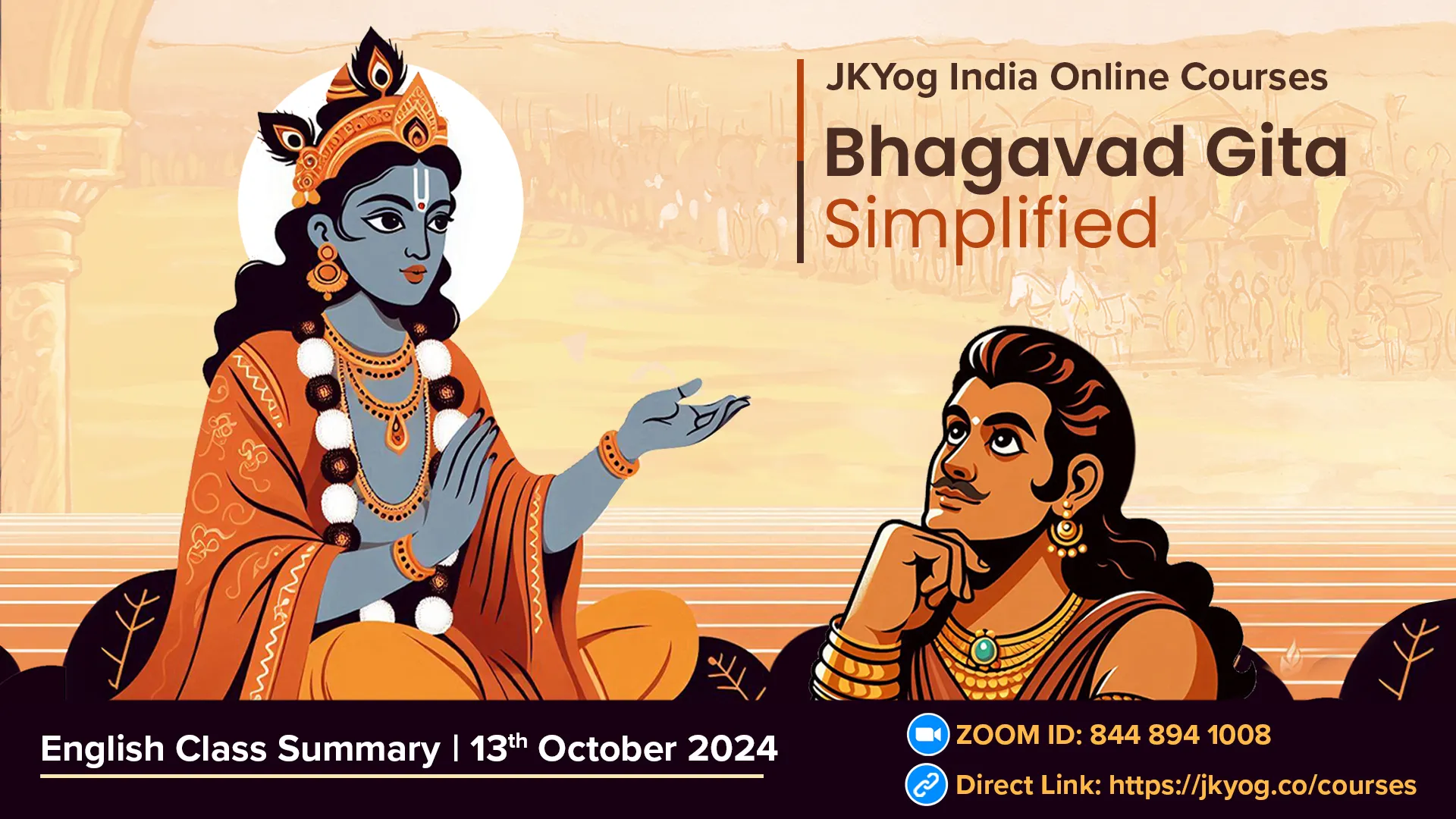In this session of the Bhagavad Gita, Shree Krishna elaborates on the principles of karma (action), the illusion of doership, and the path of ultimate surrender. The teachings in this class, drawn primarily from Chapter 18 of the Gita, guide Arjun on how to navigate the complexities of life by recognising the divine forces behind actions, overcoming ego-driven doership, and achieving liberation through surrender to the Divine.
Five Factors for accomplishment of action
Shree Krishna opens the session by explaining the five essential factors involved in the accomplishment of any action. These factors, grounded in the philosophy of Sankhya, assert that actions are never the result of a single cause but are shaped by multiple forces working together. The recognition of these forces allows for a deeper understanding of karma and how one can free oneself from its binding consequences.
अधिष्ठानं तथा कर्ता करणं च पृथग्विधम् |
विविधाश्च पृथक्चेष्टा दैवं चैवात्र पञ्चमम् ||
The body, the doer (soul), the various senses, the many kinds of efforts, and Divine Providence—these are the five factors of action. (Gita 18.14)
The five factors are:
- Adhiṣṭhanam (Body): The physical body is the vehicle through which all actions are performed. It acts as the platform for engaging in karma.
- Karta (Doer): The soul, or the living entity, is the driver of the body. It is responsible for initiating action and making decisions, yet it does not act in isolation.
- Karanam (Senses): The senses serve as the instruments of action. They are the tools that allow the soul to interact with the world and perform tasks.
- Cheshtha (Effort): Effort refers to the exertion or energy applied in carrying out an action. It is the force that transforms intention into motion.
- Daiva (Divine Providence): The role of divine will, or providence, is crucial. It refers to the circumstances and opportunities provided by God that enable or obstruct the successful completion of any action. These are determined by one’s past karmas.
Shree Krishna emphasises that all actions, whether good or bad, virtuous or sinful, are influenced by these five factors. He explains that ignorance about these influences leads to a distorted perception of reality. A person who is unaware of these factors may falsely believe they are the sole cause of their actions, leading to the development of a strong ego.
This teaching serves as a reminder that human effort alone is never sufficient for success. While the soul plays an important role as the initiator of action, it must work in conjunction with divine forces and external circumstances. This realisation helps cultivate humility and reduces the sense of pride or attachment to the outcomes of one's actions.
Ego, Doership, and Freedom
Building on the idea of the five factors, Shree Krishna next delves into the concept of doership and its relationship with the ego. He explains that the illusion of doership arises when an individual believes that they are solely responsible for their actions and achievements. This illusion is rooted in the ego, which seeks validation and recognition.
The ego-driven mindset manifests in thoughts like, “I accomplished this” or “I am the reason for this success.” Such a mentality leads to the entanglement of the soul in the web of karma, as the individual becomes attached to both the act and its results.
Shree Krishna explains that this sense of doership is misguided. The body, senses, and divine grace all play essential roles in the performance of actions. Without the body, the soul would have no medium through which to act, and without divine providence, the body itself would be lifeless.
"If the soul were not granted a body by God, it could do nothing at all. Further, if the body were not energised by divine grace, it would still be incapable of action."
However, this does not mean that the soul is entirely passive. Shree Krishna compares the soul to a driver steering a car. While the car (body) is necessary for motion, and the engine (divine energy) provides power, the driver (soul) is responsible for making decisions and navigating the road. Similarly, the soul must take responsibility for directing the body, mind, and intellect, but it should not claim full credit for the actions performed.
By attributing all accomplishments to divine grace, one can transcend the limitations of the ego. This understanding frees the individual from the desire to claim ownership over their actions and their outcomes. Instead, the soul begins to see itself as an instrument of God, performing actions for His pleasure rather than for personal gain.
"Those who are free from the ego of being the doer and whose intellect is unattached, though they may slay others, they neither kill nor are bound by their actions."
(Gita 18.17)
(Gita 18.17)
This profound verse encapsulates the essence of karma yoga. When one relinquishes the sense of doership and performs actions without attachment, they transcend the binding effects of karma. Even in situations as extreme as battle, such individuals remain unaffected by the consequences of their actions.
Knowledge, action, and the Doer
Shree Krishna then introduces the concept of the triad of knowledge, action, and the doer, which further deepens the understanding of how actions come to fruition. These three elements are interrelated and govern the way actions are initiated and executed.
- Knowledge (Jnana): Knowledge refers to the understanding or information that motivates an action. It is the foundation that shapes one’s desires and objectives.
- Object of Knowledge (Jneya): The object of knowledge is the goal or subject that the knowledge pertains to. It is the aim or purpose for which the action is performed.
- Knower (Janata): The knower is the person who possesses the knowledge and uses it to make decisions and take action.
Similarly, the triad of action includes:
- Doer (Karta): The individual or entity acting. In the human context, this is the soul working through the body.
- Instrument of action (Karaṇ): The tools or means used to perform the action. These include the senses, the mind, and external implements.
- Action (Karma): The actual task or deed being performed.
These triads are influenced by the three gunas (modes of material nature)—sattva (goodness), rajas (passion), and tamas (ignorance). Shree Krishna explains that the quality of knowledge, action, and the doer varies depending on the predominance of these guns. Sattvic actions are characterised by purity, selflessness, and alignment with higher truths, while rajasic actions are driven by desire and tamasic actions by ignorance and delusion.
Shree Krishna underscores that knowledge, action, and the doer are inseparable from the influences of the gunas. Better knowledge leads to more effective and virtuous actions, while ignorance results in actions that are harmful or self-destructive.
Karm Yog, Karm Sanyas, and Ultimate Surrender
as Shree Krishna’s teachings progress, he revisits the concept of Karm Yog (performing one’s duties with devotion) and contrasts it with Karm Sanyas (renunciation of action). Throughout the Bhagavad Gita, Krishna encourages Arjun to perform his duty as a Kshatriya while simultaneously cultivating devotion to God. This balance of material duties and spiritual practice is at the heart of Karm Yog.
Krishna explains that by performing one’s duties with the right mindset—free from attachment to the results—one can achieve perfection. This perfection is known as naiṣhkarmya-siddhi (the perfection of actionlessness), where the soul becomes detached from the fruits of its actions and attains freedom from the cycle of karma.
However, in his ultimate instruction, Krishna takes this concept a step further. He tells Arjun that there is no longer a need to perform even material duties. Instead, Arjun should renounce all worldly dharmas and surrender entirely to God.
सर्वधर्मान्परित्यज्य मामेकं शरणं व्रज |
अहं त्वां सर्वपापेभ्यो मोक्षयिष्यामि मा शुच: ||
(Gita 18.66)
This verse marks the pinnacle of Krishna’s teachings. It represents the ultimate path to liberation, where one relinquishes all attachment to material duties and focuses solely on spiritual surrender. By surrendering to God, one is freed from all sins and liberated from the cycle of birth and death.
However, Krishna cautions that this path of Karm Sanyas is not for everyone. Only those who are spiritually mature and have cultivated a deep love for God are eligible for such renunciation. For most people, it is better to continue performing their material duties while maintaining devotion in their hearts.
Shree Krishna emphasises that premature renunciation can lead to confusion and instability. Just as a student must progress through various levels of education before graduating, individuals on the spiritual path should begin with Karm Yog and gradually work towards Karm Sanyas under the guidance of a Guru.
Arjun’s Transformation: From Confusion to Clarity
at the beginning of the Bhagavad Gita, Arjun was overwhelmed with confusion and sorrow. Faced with the prospect of fighting in a battle against his relatives and teachers, he felt lost and unable to fulfil his duty as a warrior. However, through Shree Krishna’s teachings, Arjun experiences a profound transformation.
Conclusion: Shree Krishna’s Final Assurance and the Path to Liberation
The session concludes with Shree Krishna offering Arjun an eternal assurance, encapsulated in the following verse:
यत्र योगेश्वर: कृष्णो यत्र पार्थो धनुर्धर: |
तत्र श्रीर्विजयो भूतिध्रुवा नीतिर्मतिर्मम ||
"Wherever there is Shree Krishna, the Lord of all Yog, and wherever there is Arjun, the supreme archer, there will also be unending opulence, victory, prosperity, and righteousness. Of this, I am certain."
(Gita 18.78)
(Gita 18.78)
This verse emphasises the power and inevitability of success when divine wisdom and righteous action come together. Shree Krishna, the embodiment of divine knowledge and guidance, represents the inner wisdom that illuminates the path forward in times of darkness and uncertainty. Arjun, as the disciplined warrior, symbolises the ideal devotee who takes action based on divine wisdom while remaining detached from the results.
Through this assurance, Shree Krishna teaches us that the combination of wisdom and righteous action will always lead to success—not just in terms of material gains but, more importantly, in spiritual fulfilment. Victory here is not limited to worldly achievements; it encompasses the triumph of righteousness (dharma), the fulfilment of one's higher purpose, and the eventual liberation of the soul from the bondage of karma.
Summary: JKYog India Online Class- Bhagavad Gita Simplified [English]- 13th October 2024








